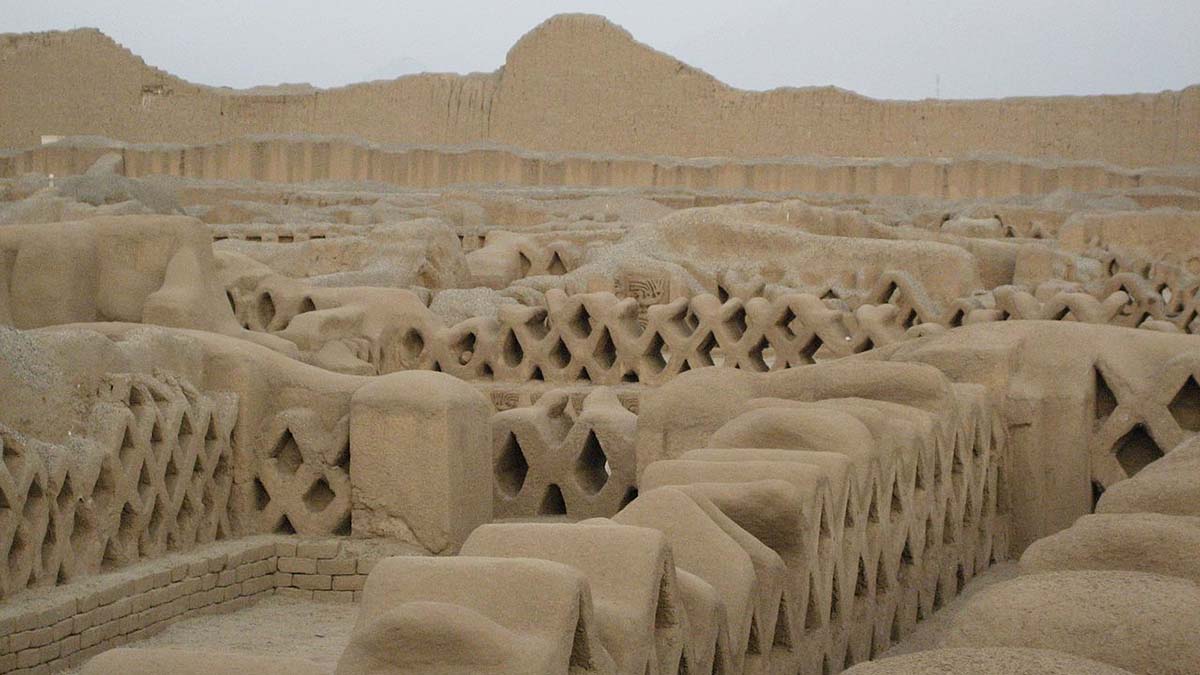
by Irene Butler
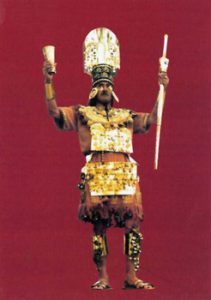 With the uncovering of over 1000 ceramic pots containing food for the afterlife, archaeologist Walter Alva knew his 1987 discovery near the village of Sipán, Peru was of major importance. I can only imagine his euphoria when under the pots he unearthed a sarcophagus of a king in royal splendour, and deeper digs revealed other kings and priests – the Lords of Sipán.
With the uncovering of over 1000 ceramic pots containing food for the afterlife, archaeologist Walter Alva knew his 1987 discovery near the village of Sipán, Peru was of major importance. I can only imagine his euphoria when under the pots he unearthed a sarcophagus of a king in royal splendour, and deeper digs revealed other kings and priests – the Lords of Sipán.
There are two ways to get to Sipán; the easy way is to fly from Lima to Chiclayo (which is 30km from Sipán). Or for the more adventurous, such as my husband Rick and myself, hop a bus heading north. A bonus of overland travel is being able to take in the treasure trove of sites along the 760 kilometer route.
Northern Peru is considered “off the gringo trail” since nine out of ten travelers to the country head south, the draw being Machu Picchu and other Inca ruins. Our first bivouac north of Lima is to the town of Trujillo (tra-HEE-yo) – the absence of souvenir shops and touristy restaurants speaks for itself – we are going against the grain.
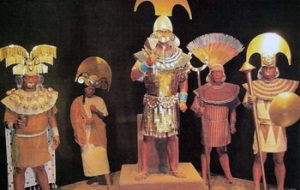 The most prominent ruin in the Trujillo area is Huaca de la Luna, a 10-storey adobe pyramid of the pre-Inca Moche Empire. From the outside this temple, built in stages between 100-700AD, appears to be a gigantic mound of clay. Upon entering our eyes widen at the sight of mud walls curiously cut away, revealing levels painted with geometric figures and mythological beings. As we gaze at the elaborate mosaics in shades of magenta, gold, green and black, our guide Juan explains that each new century the Moche sealed the bodies of their deceased rulers into the pyramid by completely covering the tombs with a new stepped platform. Thus with archaeologists slicing through the eight-level pyramid, we are awarded this amazing glimpse of condensed history.
The most prominent ruin in the Trujillo area is Huaca de la Luna, a 10-storey adobe pyramid of the pre-Inca Moche Empire. From the outside this temple, built in stages between 100-700AD, appears to be a gigantic mound of clay. Upon entering our eyes widen at the sight of mud walls curiously cut away, revealing levels painted with geometric figures and mythological beings. As we gaze at the elaborate mosaics in shades of magenta, gold, green and black, our guide Juan explains that each new century the Moche sealed the bodies of their deceased rulers into the pyramid by completely covering the tombs with a new stepped platform. Thus with archaeologists slicing through the eight-level pyramid, we are awarded this amazing glimpse of condensed history.
As gold was buried with the royals, these tombs were the target of relentless plundering since colonial times. Juan, now in his 30s says, “When I was a young boy my parents warned me to stay far away from this pyramid because of grave robbers.”
Fortuitously, in 1997 an area with gold disks and textiles was found that had been missed by thieves (the items now housed in a Chiclayo museum). A year earlier excavations behind the pyramid revealed the skeletons of 40 men, aged 15-35, believed to have been sacrificed to stop the El Niño rains which partially destroyed the temple circa 750AD.
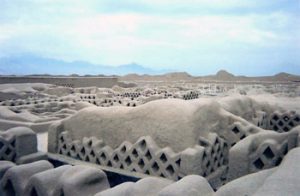 Still in the Trujillo area, our route followed the chronology of the ancients. After the decline of the Moche, the Chimú civilization emerged in 900AD. By 1300 AD their adobe domain Chan Chan covered 20 square kilometers (4940 acres), becoming one of the largest pre-Inca empires. It was abandoned in the 1470s when Chimús were overrun by an Inca army.
Still in the Trujillo area, our route followed the chronology of the ancients. After the decline of the Moche, the Chimú civilization emerged in 900AD. By 1300 AD their adobe domain Chan Chan covered 20 square kilometers (4940 acres), becoming one of the largest pre-Inca empires. It was abandoned in the 1470s when Chimús were overrun by an Inca army.
In its heyday this complex is believed to have sustained a population of 60,000. Dwellings are interspersed by storage bins for food, huge walk in wells, workshops, and temples. In the centre of the complex are 10 royal compounds built by the succession of rulers. In 1983 and then again in 1998 El Niño unfurled its watery destruction, badly eroding the adobe, but also uncovering bodies with gold masks.
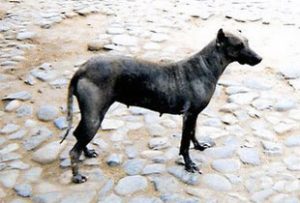 While walking about the site, I find myself cringing at what I think are diseased dogs, until Juan points out they are fine specimens of the Peruvian Hairless (declared in 1986 as a distinct breed by Kennel Club International). From paintings on the ceramics and dog skeletons found in tombs, it is believed this type of “naked” dog has been around for nigh on 4000 years, thus deserving mention with the relics of old. The locals tell of their legendary healing properties. Contact with their skin is said to cure asthma in children, and with their unusually high body temperature they are hauled off to bed like hot-water-bottles by arthritics.
While walking about the site, I find myself cringing at what I think are diseased dogs, until Juan points out they are fine specimens of the Peruvian Hairless (declared in 1986 as a distinct breed by Kennel Club International). From paintings on the ceramics and dog skeletons found in tombs, it is believed this type of “naked” dog has been around for nigh on 4000 years, thus deserving mention with the relics of old. The locals tell of their legendary healing properties. Contact with their skin is said to cure asthma in children, and with their unusually high body temperature they are hauled off to bed like hot-water-bottles by arthritics.
Our next northbound bus is to the bustling city of Chiclayo. From here we taxi to the much anticipated Moche ruin of Huaco Rajada (Cracked Pyramid) near the village of Sipán where the Lords were discovered in a most bizarre way.
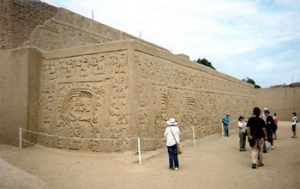 A call from police at midnight alerted archaeologist Walter Alva to hasten to the site where they had interrupted grave robbers hauling out rice sacks stuffed with gold antiquities. It became apparent this was not the first visit from robbers, but fortunately the looting had been confined to this one chamber.
A call from police at midnight alerted archaeologist Walter Alva to hasten to the site where they had interrupted grave robbers hauling out rice sacks stuffed with gold antiquities. It became apparent this was not the first visit from robbers, but fortunately the looting had been confined to this one chamber.
Excavation was soon underway. Directly below the ceramics Alva came across the skeleton of a sentry with feet cut off, believed to have symbolized eternal vigil – plus a standard bearer, three young women, a child, two llamas and a dog buried with this ruler. This funerary chamber (carbon dated 300AD), was followed by a series of discoveries; the latest in 2007 being chamber #14.
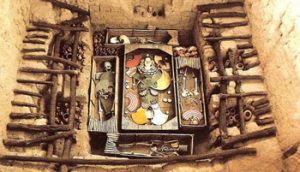 The Museo Tumbas Reales de Sipán (Royal Tombs of Sipán Museum), where these treasures now rest, is like being time-warped back to the grandeur and sophistication of this ancient civilization.
The Museo Tumbas Reales de Sipán (Royal Tombs of Sipán Museum), where these treasures now rest, is like being time-warped back to the grandeur and sophistication of this ancient civilization.
Moving from display to display, I was awestruck by the exquisitely crafted masks, jewellery, and sceptres of gold and silver embedded with turquoise. I had to agree with Rick’s proclamation, “King Tut had nothing over the Lords of Sipán.”
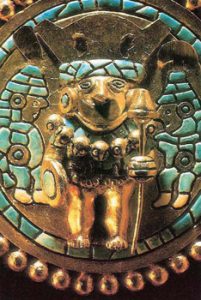 A mausoleum to these ancient leaders, their bones arranged in wooden coffins, is the final riveting exhibition.
A mausoleum to these ancient leaders, their bones arranged in wooden coffins, is the final riveting exhibition.
Ready to leave Chiclayo, a glance at a map had us rationalizing, “Why not continue another seven hours north when we have already come so far – especially when the added distance means a week at Mancora Beach.”
Miles of fine sand backed by a riot of palms and caramel coloured hills greeted us. Surfers bragged about always catching a good wave. There isn’t a high-rise hotel in sight; and most of the moderately sized accommodations are Peruvian owned.

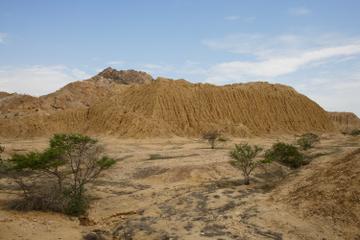
Chiclayo Private Archeological Tour:
Huaca Rajada, Tucume and Sipan Royal Tombs
If You Go:
BUS
Panamerican Hwy from Lima to Trujillo
– 554 km (approx 9 hours)
Panamerican Hwy from Trujillo to Chiclayo
– 206 km (approx 3 hours)
Chiclayo to Mancora Beach – (approx 7 hours)
AIR
AeroCondor Flights leave regularly from …
– Lima to Chiclayo (approx 1 hour)
– Tumbes to Lima (approx 1 ½ hours)
More Information:
Inka Natura Travel – Northern Peru
Chan Chan Archaeological Zone was declared a UNESCO World Heritage Site in 1986
Museo Tumbas Reales de Sipán – in Lambayeque – ll km N of Chiclayo
The Lords of Sipán excavation site – near Sipán village – 30 km E of Chiclayo.
About the author:
Irene Butler and her husband Rick are a travel journalist/photographer team from Kelowna, B.C. They lead a gypsy existence traveling around the world for six months of each year. Their tally is 53 countries visited to date. Web Site: www.globaltrekkers.ca
Photo Credits:
First Chan Chan Archaeological Zone by Jim Williams / CC BY-SA 3.0-IGO
All other photos are by Rick Butler.



Leave a Reply
You must be logged in to post a comment.